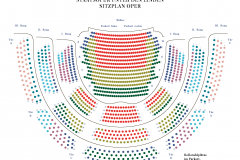Roméo et Juliette
Mo | Tu | We | Th | Fr | Sa | Su |
DRAME LYRIQUE IN FIVE PARTS (1867)
MUSIC FROM: Charles Gounod
TEXT FROM: Jules Barbier and Michel Carré after William Shakespeare
The most famous lovers ever: virtually mythical figures, Romeo and Juliette from Shakespeare’s eponymous drama have dominated world literature ever since its premiere in 1597. Among the many musical settings of the work, Charles Gounod’s Roméo et Juliette is one of the most performed. It was a triumphant success already at its premiere as part of the 1867 Paris Exposition. Gounod focuses particularly on the emotional life of the two lovers, for whom he composes no fewer than four love duets. At the same time, he also explores the social context of their forbidden love in the form of powerful choral tableaux and a large fight scene between the enemy families. In this production, director Mariame Clément will place the focus on the youth of the title characters, presenting them not as an exaggerated ideal of a couple, but as young people of today who find their way to another despite all odds.
Synopsis
The play, set in Verona, Italy, begins with a street brawl between Montague and Capulet servants who, like the masters they serve, are sworn enemies. Prince Escalus of Verona intervenes and declares that further breach of the peace will be punishable by death. Later, Count Paris talks to Capulet about marrying his daughter Juliet, but Capulet asks Paris to wait another two years and invites him to attend a planned Capulet ball. Lady Capulet and Juliet's Nurse try to persuade Juliet to accept Paris's courtship.
Meanwhile, Benvolio talks with his cousin Romeo, Montague's son, about Romeo's recent depression. Benvolio discovers that it stems from unrequited infatuation for a girl named Rosaline, one of Capulet's nieces. Persuaded by Benvolio and Mercutio, Romeo attends the ball at the Capulet house in hopes of meeting Rosaline. However, Romeo instead meets and falls in love with Juliet. Juliet's cousin, Tybalt, is enraged at Romeo for sneaking into the ball but is stopped from killing Romeo by Juliet's father, who does not wish to shed blood in his house. After the ball, in what is now famously known as the "balcony scene," Romeo sneaks into the Capulet orchard and overhears Juliet at her window vowing her love to him in spite of her family's hatred of the Montagues. Romeo makes himself known to her, and they agree to be married. With the help of Friar Laurence, who hopes to reconcile the two families through their children's union, they are secretly married the next day.
Tybalt, meanwhile, still incensed that Romeo had sneaked into the Capulet ball, challenges him to a duel. Romeo, now considering Tybalt his kinsman, refuses to fight. Mercutio is offended by Tybalt's insolence, as well as Romeo's "vile submission",and accepts the duel on Romeo's behalf. Mercutio is fatally wounded when Romeo attempts to break up the fight, and declares a curse upon both households before he dies. ("A plague on both your houses!") Grief-stricken and racked with guilt, Romeo confronts and slays Tybalt.
Montague argues that Romeo has justly executed Tybalt for the murder of Mercutio. The Prince, now having lost a kinsman in the warring families' feud, exiles Romeo from Verona, under penalty of death if he ever returns. Romeo secretly spends the night in Juliet's chamber, where they consummate their marriage. Capulet, misinterpreting Juliet's grief, agrees to marry her to Count Paris and threatens to disown her when she refuses to become Paris's "joyful bride". When she then pleads for the marriage to be delayed, her mother rejects her.
Juliet visits Friar Laurence for help, and he offers her a potion that will put her into a deathlike coma or catalepsy for "two and forty hours". The Friar promises to send a messenger to inform Romeo of the plan so that he can rejoin her when she awakens. On the night before the wedding, she takes the drug and, when discovered apparently dead, she is laid in the family crypt.
The messenger, however, does not reach Romeo and, instead, Romeo learns of Juliet's apparent death from his servant, Balthasar. Heartbroken, Romeo buys poison from an apothecary and goes to the Capulet crypt. He encounters Paris who has come to mourn Juliet privately. Believing Romeo to be a vandal, Paris confronts him and, in the ensuing battle, Romeo kills Paris. Still believing Juliet to be dead, he drinks the poison. Juliet then awakens and, discovering that Romeo is dead, stabs herself with his dagger and joins him in death. The feuding families and the Prince meet at the tomb to find all three dead. Friar Laurence recounts the story of the two "star-cross'd lovers", fulfilling the curse that Mercutio swore. The families are reconciled by their children's deaths and agree to end their violent feud. The play ends with the Prince's elegy for the lovers: "For never was a story of more woe / Than this of Juliet and her Romeo."
Program and cast
Language: In French language with German and English surtitles
Recommended age: 12 years and older
Insight before the premiere on 4th november 2024
CAST
MUSICAL DIRECTOR: Giuseppe Mentuccia
DIRECTOR: Mariame Clément
SET DESIGN, COSTUMES: Julia Hansen
CHOREOGRAPHY: Mathieu Guilhaumon
STUNTKOORDINATOR: Ran Arthur Braun
LIGHT: Ulrik Gad
VIDEO: Sébastien Dupouey
CHORUS MASTER: Dani Juris
DRAMATURGY: Christoph Lang
JULIETTE: Nino Machaidze
GERTRUDE: Katharina Kammerloher
TYBALT: Johan Krogius
COMTE PARIS: David Oštrek
COMTE CAPULET: Arttu Kataja
GRÉGORIO: Taehan Kim
ROMÉO: Long Long
STÉPHANO: Corinna Scheurle
BENVOLIO: Gonzalo Quinchahual
MERCUTIO: Jaka Mihelač
FRÈRE LAURENT: Nicolas Testé
LE DUC DE VERONE: Manuel Winckhler
STAATSOPERNCHOR
STAATSKAPELLE BERLIN
State Opera Unter den Linden
Staatsoper Unter den Linden is one of Berlin's most prestigious opera houses, with a rich history and significant cultural impact.
History:
The Staatsoper Unter den Linden was originally built between 1741 and 1743, under the direction of architect Georg Wenzeslaus von Knobelsdorff. It was commissioned by Frederick II of Prussia and was initially named the Königliche Oper (Royal Opera). The opera house has undergone several renovations and reconstructions, notably after World War II damage. It reopened in 1984, following a major renovation.
Construction:
The original design was characterized by its Baroque style, featuring an elegant façade and a grand entrance. The building was reconstructed in the 1950s and 1980s, maintaining its classical exterior while modernizing the interior. The façade features a classic portico with six Corinthian columns and a prominent central pediment.
Interior:
The interior is known for its opulent and classical design. The auditorium is renowned for its acoustics and grandeur, with luxurious velvet seats and elaborate decorations. The stage and seating areas have been updated to meet modern performance standards while preserving historical aesthetics.
Concerts and Performances:
The Staatsoper Unter den Linden hosts a variety of performances, including operas, orchestral concerts, and ballet. It is home to the Staatskapelle Berlin, one of Germany's leading orchestras. The opera house is celebrated for its high-quality productions and its role in Berlin’s vibrant cultural scene.
JOURNEY
The Staatsoper Unter den Linden has completely barrier-free access due to its excellent public transport connections.
ADDRESS: Unter den Linden 7; 10117 Berlin
SUBURBAN RAILWAY
S+U Friedrichstraße (S1, S2, S5, S7, S25, S75)
SUBWAY
Hausvogteiplatz (U2)
Museumsinsel (U5)
Stadtmitte (U2, U6)
Unter den Linden (U5, U6)
BUS
Staatsoper (100, 245, 300)
Unter den Linden/Friedrichstraße (100, 147, 245, 300, N6)
PARKING
Q-PARK parking garage Unter den Linden/Staatsoper
Bebelplatz, 10117 Berlin
There are five electric charging stations in the parking garage. Further information can be found here.
The underground car park on Bebelplatz offers disabled parking spaces and direct access to the opera house. On entering the car park between 5.30pm and 11.30pm, the maximum parking fee is €7. To use this tariff, enter your parking ticket in one of the pay machines and the message »Theatertarif« will appear on the display. Please note that it is not possible to use the tariff if you enter the car park before 5.30pm. so it will not be shown on the display. TIP: If you pay the theatre tariff at the pay machine before the event, you can avoid unnecessary waiting after the show.

 EN
EN DE
DE IT
IT FR
FR ES
ES RU
RU JP
JP RO
RO
 Seating plan
Seating plan 